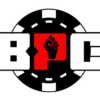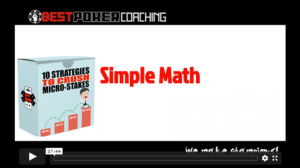Facing a minimum re-raise preflop happens more at the lowest stakes, so this article is generally for players at 25NL or lower and therefore won’t be overly complicated. The reason you encounter these min 3-bets more often at these stakes is because there are more recreational players (fish) on average who have less knowledge of the game (i.e. – math, odds, etc).
Surely, these min 3-bets can be quite annoying, but we need to know how to react to them so we don’t get owned by the fish. Of course, they will show up with a big hand sometimes – fish get Aces too! But more often than not, these re-raises are given entirely too much credit. I see players min 3-bet way more often with hands like KJ, QJ, AT which are easily dominated when we hold a hand with a better kicker. I also see a lot of min 3-bets with small and medium pocket pairs. They’re re-raising here preflop to protect their small pair from overcards on later streets. So, depending on the player, don’t be afraid to play a 3-bet pot or 4-bet for value with a slightly wider range.
So how to tell the difference? Well, let’s go over some general guidelines regarding player types. Again, we’ll most likely be up against a weak player when facing a min 3-bet, so I’m not even going to discuss regular-type players, often referred to as TAGs, LAGs, and nits. No, I’m specifically referring to super passive fish (60/5), maniacs (70/45), as well as semi-loose passive players (30/5).
Maniacs will obviously have a much wider range and are just seeking action. They’re fooling around. Don’t be afraid to call with mediocre hands where you would otherwise fold vs a reg. Don’t give these raises respect as their range is literally any two cards! If you hit top pair on the flop, give them a rope and let them hang themselves – just call down. Of course, stack size does play a part, as well as who’s left to act behind, but we’ll discuss that further below.
Loose-passives will typically show up with a much stronger range, but again, it’s not always AA. Depending on their total 3-bet frequency and sample size, you should be able to estimate a solid 3-bet range. So in general, we should give these players more respect than the maniac, and even more so the shorter they are on chips. Of course, if you have a big hand yourself, go ahead and play the hand because fish hate to fold, especially in 3-bet pots. Obviously, we’d prefer to have position postflop in this case but in these situations.
In addition to player types and tendencies, we also need to look at stack size when deciding our action. In no-limit, implied odds are a big factor in our decision process. For example, an action we take vs a player with a 40bb stack probably won’t be applicable to a player with 100bb stack. Against a player with a short stack of say 25bb, there isn’t going to be much maneuverability postflop. This means fold equity will be at a minimum, which we can use to our advantage when deciding to continue or not. So in other words, we need to decide whether we’re stacking off now or on the flop. If we’re not willing to get the money in, or are just unsure, it’s best to just fold and move on.
Now facing a min 3-bet from a player with a 50bb stack gets a little trickier, but also leaves some maneuverability should we completely miss the flop. In this instance, it’s perfectly acceptable to call and see a flop with hands like 99, AQo, ATs because implied odds are a little higher. And if we flop well, we should be looking to get our stack in. Of course, we should still fold most of the time and especially when we’ll be out of position postflop, but don’t be afraid to mix it up with hands you’d otherwise fold vs regs.
You probably won’t be facing too many min 3-bets from players that have 100bb+ stacks simply because weaker players generally play with smaller stacks (and often leave the table when they double up). But in this case, we can call much wider because implied odds are at their highest. This is where we can call with a ton of our range with hands like suited connectors, small pocket pairs, and broadway combos, and try to flop a big hand. Even if we’re on the button and get min 3-bet from the BB, we can still profitably call with hands like T9o, K8s, A5o, etc. If we miss the flop, we simply fold, since there’s not much logic in trying to bluff-raise a weaker player – they just don’t fold often enough.
In conclusion, always be aware of the player type, their 3-bet frequency, and the stack size before making a decision when facing a min 3-bet. Here’s some homework. Find at least 20 hands where you faced a preflop min 3-bet and saw a flop with. Then review the hand based on the information in this article to see if there’s anything you should have done differently. That should be enough to get you started on creating good habits when facing min 3-bets. Good luck!



